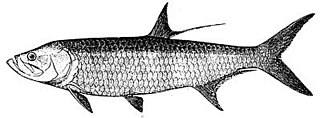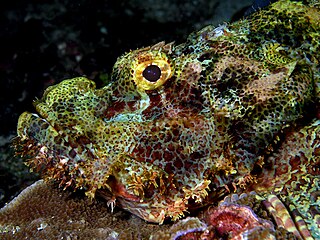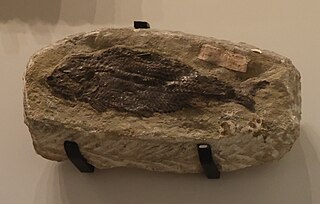
Actinopterygii, members of which are known as ray-finned fishes, is a class of bony fish. They comprise over 50% of living vertebrate species.

Catfish are a diverse group of ray-finned fish. Named for their prominent barbels, which resemble a cat's whiskers, catfish range in size and behavior from the three largest species alive, the Mekong giant catfish from Southeast Asia, the wels catfish of Eurasia, and the piraíba of South America, to detritivores, and even to a tiny parasitic species commonly called the candiru, Vandellia cirrhosa. Neither the armour-plated types nor the naked types have scales. Despite their name, not all catfish have prominent barbels or "whiskers". Members of the Siluriformes order are defined by features of the skull and swimbladder. Catfish are of considerable commercial importance; many of the larger species are farmed or fished for food. Many of the smaller species, particularly the genus Corydoras, are important in the aquarium hobby. Many catfish are nocturnal, but others are crepuscular or diurnal.

The Elopiformes are the order of ray-finned fish including the tarpons, tenpounders, and ladyfish, as well as a number of extinct types. They have a long fossil record, easily distinguished from other fishes by the presence of an additional set of bones in the throat.

Callichthyidae is a family of catfishes, called armored catfishes due to the two rows of bony plates along the lengths of their bodies. It contains some of the most popular freshwater aquarium fish, such as many species in the genus Corydoras.

The Scorpaenidae are a family of mostly marine fish that includes many of the world's most venomous species. As their name suggests, scorpionfish have a type of "sting" in the form of sharp spines coated with venomous mucus. The family is a large one, with hundreds of members. They are widespread in tropical and temperate seas but mostly found in the Indo-Pacific. They should not be confused with the cabezones, of the genus Scorpaenichthys, which belong to a separate, though related, family, Cottidae.

Loricariidae is the largest family of catfish, with 92 genera and just over 680 species. Loricariids originate from freshwater habitats of Costa Rica, Panama, and tropical and subtropical South America. These fish are noted for the bony plates covering their bodies and their suckermouths. Several genera are sold as "plecos", notably the suckermouth catfish, Hypostomus plecostomus, and are popular as aquarium fish.

The superorder Elopomorpha contains a variety of types of fishes that range from typical silvery-colored species, such as the tarpons and ladyfishes of the Elopiformes and the bonefishes of the Albuliformes, to the long and slender, smooth-bodied eels of the Anguilliformes. The one characteristic uniting this group of fishes is they all have leptocephalus larvae, which are unique to the Elopomorpha. No other fishes have this type of larvae.

The Ariidae or ariid catfish are a family of catfish that mainly live in marine waters with many freshwater and brackish water species. They are found worldwide in tropical to warm temperate zones. The family includes about 143 species.

Pholidophorus is an extinct genus of stem-teleost fish. Numerous species were assigned to this genus in the past, but only the type species Pholidophorus latiusculus, from the Late Triassic of Europe, is considered to be a valid member of the genus today.

Diplomystidae, the velvet catfishes, are a family of primitive catfishes endemic to freshwater habitats in Argentina and Chile in southern South America. It currently contains six species in two genera.
Silvinichthys is a genus of fish in the family Trichomycteridae endemic to Argentina.
Diplomystes camposensis is a species of velvet catfish endemic to Chile where it occurs in the Valdivia region. It grows to a length of 25.0 centimetres (9.8 in) TL and is commercially caught as well as being a gamefish.
Olivaichthys is a genus of velvet catfishes endemic to Argentina.

Diplomystes nahuelbutaensis is a species of velvet catfish endemic to Chile where it occurs in the Bío-Bío River basin and in the Loncomilla River. It grows to a length of 26.0 centimetres (10.2 in) TL and is a component of local commercial fisheries as well as being a gamefish.
Protoclupea is an extinct genus of ray-finned fish that lived from the Oxfordian to the early Tithonian stage of the Late Jurassic epoch. It contains one species, Protoclupea chilensis, fossils of which have been found in the Domeyko Range of Antofagasta Region, northern Chile. The genus has been placed in the family Varasichthyidae together with the genera Bobbichthys, Domeykos, Luisichthys and Varasichthys.

Orthocormus is an extinct genus of prehistoric pachycormiform bony fish. It is known from three species found in Late Jurassic (Kimmeridgian) aged plattenkalk deposits in Bavaria, Germany. The species "Hypsocormus" tenuirostris Woodward 1889 from the late Middle Jurassic (Callovian) Oxford Clay is not closely related to the type species of Hypsocormus, and is more closely related to Orthocormus + Protosphyraena, and thus has sometimes been referred to in open nomenclature as Orthocormus? tenuirostris.

Thoracopteridae is an extinct family of prehistoric bony fish; classified with the order Peltopleuriformes. This lineage of Triassic flying fish-like Perleidiformes converted their pectoral and pelvic fins into broad wings very similar to those of their modern counterparts. However, this group is not related to modern flying fish from the family Exocoetidae, instead being a case of convergent evolution.

Otocephala is a clade of ray-finned fishes within the infraclass Teleostei that evolved some 230 million years ago. It is named for the presence of a hearing (otophysic) link from the swimbladder to the inner ear. Other names proposed for the group include Ostarioclupeomorpha and Otomorpha.

Orthogonikleithrus is a genus of extinct ray-finned fish that lived during the Late Jurassic period. It lived in lagoonal and restricted shallow subtidal zones.

Dorsetichthys is an extinct genus of stem-teleost ray-finned fish from the Early Jurassic period of Europe.















